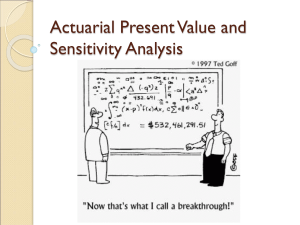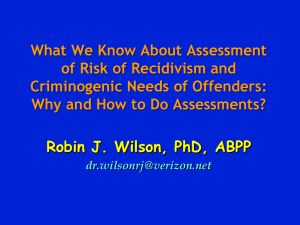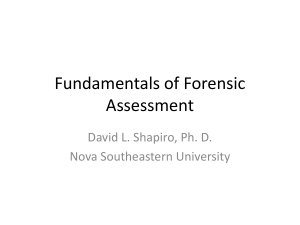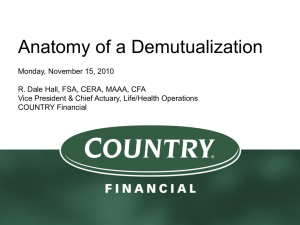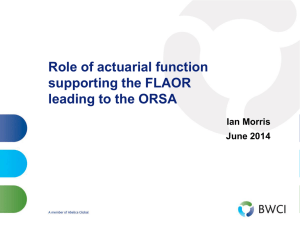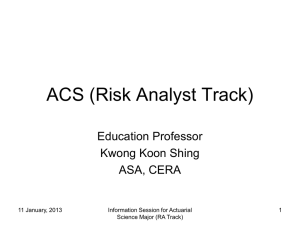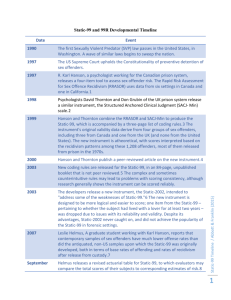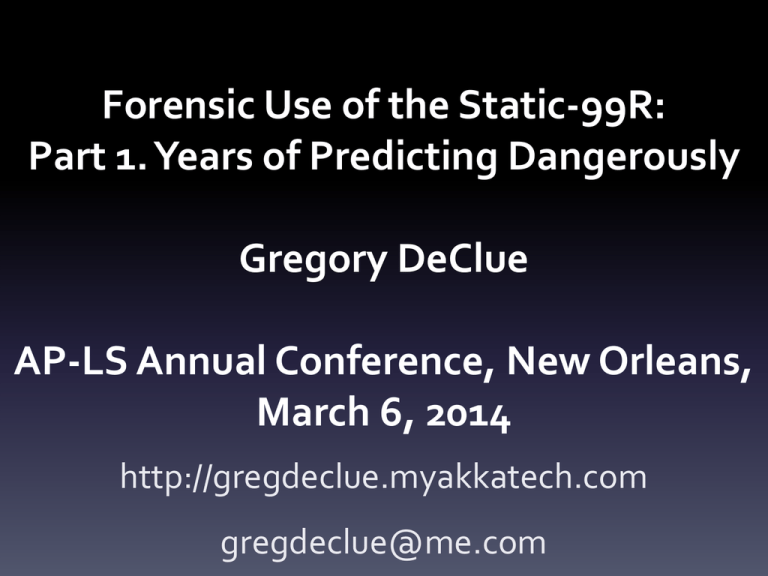
Forensic Use of the Static-99R:
Part 1. Years of Predicting Dangerously
Gregory DeClue
AP-LS Annual Conference, New Orleans,
March 6, 2014
http://gregdeclue.myakkatech.com
gregdeclue@me.com
Forensic Use of the Static-99R
Part 1
Open Access Journal of Forensic Psychology
www.forensicpsychologyunbound.ws
DeClue, G. (2013). Years of predicting
dangerously. Open Access Journal of
Forensic Psychology, 5, 16-28.
DeClue, G., & Campbell, T. W. (2013).
Calibration performance indicators for the
Static-99R: 2013 update. Open Access
Journal of Forensic Psychology, 5, 81-88.
Forensic Use of the Static99R:
Part 3. Choosing a
Comparison Group
Open Access Journal of Forensic Psychology
www.forensicpsychologyunbound.ws
"Perhaps most important, there [are]
no data on the validity of adjusted
actuarial assessment of risk for sexual
reoffending, the technique used by
almost all professionals who employ
actuarial tests in their assessments"
(p. 3-8)
Petrila, J., & Otto, R.K. (2001). Admissibility of expert testimony in sexually violent
predator proceedings. In A. Schlank (Ed.), The sexual predator: Legal issues, clinical
issues, special populations - Volume II. Kingston, NJ: Civic Research Institute.
A decade later, there are data,
and the data thus far show that
clinical adjustments or
overrides reduce the accuracy
of actuarial-based risk
prediction.
What then must we do?
“The evaluator’s clinical opinion shall
be the product of clinical judgment
guided by the application of
assessment instruments helpful in the
prediction of sexual offender
recidivism.”
https://www.flrules.org/gateway/ChapterHome.asp?Chap
ter=65E-25
However, there is no empirical
evidence that consideration of
additional factors increases the
accuracy of the actuarial-based
risk assessment.
A Brief Timeline
1997
✔ prior sex offenses
any prior nonsex offenses
✔ any male victims
any stranger victims
✔ any unrelated victims
never married
✔ age less than 25 years
RRASOR
1998
Three plausible approaches to
conducting risk assessments:
guided clinical,
pure actuarial,
adjusted actuarial.
Hanson, R. K. (1998). What do we know about sex offender
risk assessment? Psychology, Public Policy, and Law, 4, 50-72.
In the guided clinical approach,
expert evaluators consider a wide
range of empirically validated risk
factors and then form an overall
opinion concerning the offender's
recidivism risk.
In contrast, the pure actuarial
approach evaluates the offender
on a limited set of predictors and
then combines these variables
using a predetermined, numerical
weighting system.
The adjusted actuarial approach
begins with an actuarial prediction, but expert evaluators can
then adjust (or not) the actuarial
prediction after considering
potentially important factors that
were not included in the actuarial
measure.
2000
Static-99
✔ never married
noncontact sex offenses
✔ stranger victims
current nonsexual violence
prior nonsexual violence
four or more sentencing dates
Hanson, R. K., & Thornton, D. (2000). Improving risk assessments for
sex offenders: A comparison of three actuarial scales. Law and Human
Behavior, 24, 119-136.
Hanson and Thornton found
that the 10-item Static-99 was
more accurate than the 4-item
RRASOR, but not by much:
“The incremental improvement
of Static-99, however, was
relatively small” (p. 129)
How small was it?
According to their Table 4 on
page 126, Receiver Operating
Characteristic (ROC) Area for
RRASOR was 0.68, with a 95%
confidence interval (CI) of 0.65
to 0.72. ROC Area for Static-99
was 0.71, with a 95% CI of 0.68
to 0.74.
That is, adding six new items,
which more than doubled the
total number of items,
increased overall accuracy of
sex-offense risk by a small
amount.
Static-99 does not claim to
provide a comprehensive
assessment, for it neglects
whole categories of potentially
relevant variables (e.g.,
dynamic factors).
Consequently, prudent evaluators
would want to consider whether
there are external factors that
warrant adjusting the initial score
or special features that limit the
applicability of the scale (e.g., a
debilitating disease or stated
intentions to reoffend).
Given the poor track record of
clinical prediction, however,
adjustments to actuarial
predictions require strong
justifications. In most cases,
the optimal adjustment would
be expected to be minor or
none at all.
2002
"Much more research is
required before adjustments to
established actuarial measures
using static factors can be done
with any confidence” (p. 100).
Hanson, R. K. (2002). Introduction to the Special Section on dynamic
risk assessment with sex offenders. Sexual Abuse: A Journal of Research
and Treatment, 14, 99-101.
2005
“The best methods for
combining risk factors into an
overall evaluation remain an
active topic of scientific
debate.”
Hanson, R. K., & Morton-Bourgon, K. (2005). The characteristics of
persistent sexual offenders: A meta-analysis of recidivism studies.
Journal of Consulting and Clinical Psychology, 73, 1154-1163.
2009
The developers of the
instruments now recommend
the Static-99R rather than the
Static-99 for all purposes.
Three studies examined the
difference between actuarial
scores and adjusted actuarial
risk ratings (Gore, 2007;
Hanson, 2007; Vrana, Sroga, &
Guzzo, 2008).
Hanson, R. K., & Morton-Bourgon, K. E. (2009). The accuracy of
recidivism risk assessments for sexual offenders: A meta-analysis of 118
prediction studies. Psychological Assessment, 21, 1-21.
Study
Instrument
Raters
Gore (2007)
MnSOST-R
Psych or DOC
Hanson (2007)
Static-99
Prob. Ofcrs.
Vrana et al.
(2008)
Storey et al.
(2012)
Wormith et al.
(2012)
LSI-OR
Prob. Ofcrs.
Static-99
Clinicians
LS-CMI
Mixed (mostly
Prob. Ofcrs.)
In these studies, evaluators were
required to complete an actuarial
risk tool and then were allowed to
adjust the final risk rating on the
basis of factors external to the
actuarial tool.
Gore, K. S. (2007). Adjusted actuarial assessment of sex offenders: The
impact of clinical overrides on predictive accuracy. Dissertation
Abstracts International, 68(07), 4824B. (UMI No. 3274898).
All three studies were
prospective, and evaluators
completed the ratings as part
of their routine procedures.
Hanson, R. K. (March 2007). How should risk assessments for sexual
offenders be conducted? Paper presented at the Fourth Annual Forensic
Psychiatry Conference, Victoria, British Columbia, Canada.
For all three measures, for all
types of raters, and for all
outcomes, the adjusted scores
showed lower predictive
accuracy than did the
unadjusted actuarial scores.
Vrana, G. C., Sroga, M., & Guzzo, L. (2008). Predictive validity of the LSI–
OR among a sample of adult male sexual assaulters. Unpublished
manuscript, Nipissing University, North Bay, Ontario, Canada.
“Based on available data, at its
best, AAA neither increases nor
decreases the accuracy of actuarial
classification. At its worst, AAA
dilutes actuarial accuracy.”
Campbell, T. W., & DeClue, G. (2010a). Flying blind with naked factors:
Problems and pitfalls in adjusted-actuarial sex-offender risk
assessment. Open Access Journal of Forensic Psychology, 2, 75-101.
How do adjustments or
overrides to actuarial risk
assessments dilute accuracy?
Example follows:
Clinical overrides that increased
predicted risk resulted in 4 more
true positives (people rated at high
risk, who actually sexually
recidivated) but at the cost of 75
fewer true negatives (people rated
as low risk, who actually did not
sexually recidivate).
2012
“In 30 cases, clinicians used discretion
to ‘override’ or adjust the Static-99
ratings when making final risk
judgments, but the predictive validity
of the clinical adjusted ratings was
worse than that of the original Static99 ratings made by clinicians” (p. 1).
Storey, J. E., Watt, K. A., Jackson, K. J., & Hart, S. D. (published online
February 17, 2012). Utilization and implications of the Static-99 in
practice. Sexual Abuse: A Journal of Research and Treatment.
“The clinical override scores
were less predictive of sexual
recidivism than the scores
without overrides.”
The ratings with overrides
predicted recidivism in the wrong
direction—that is, clinical overrides
of increased risk were actually
associated with lower recidivism
rates and vice versa” (p. 8).
Storey et al. concluded,
“Clinical judgment reduced the
predictive accuracy of the
Static-99 in our study. . . .
On the basis of our findings,
additional and more detailed
guidelines regarding the
appropriate use of overrides
should be tested empirically
and provided to clinicians.
Alternatively, clinicians should
be discouraged from overriding
Static-99 scores under any
circumstances” (pp. 10-11).
“The study revealed that
allowing assessors to override
the numerically derived risk
level with their professional
judgment, …
Wormith, J. S., Hogg, S., & Guzzo, L. (2012). The predictive validity of a general
risk/needs assessment inventory on sexual offender recidivism and an exploration of
the professional override. Criminal Justice and Behavior, 39, 1511-1538.
reduced the predictive validity
of the scale and did so
particularly for sex offenders by
increasing risk excessively” (p.
1511).
2013
Looman, J., Morphett, N. A. C., &
Abracen, J. (2012). Does consideration
of psychopathy and sexual deviance
add to the predictive validity of the
Static-99R? International Journal of
Offender Therapy and Comparative
Criminology. Advance online
publication.
Nope.
What then must we do?
As scientist-practitioners, SVP
evaluators should apply the
results of scientific studies to
the cases we evaluate.
If the research showed that
adjusted-actuarial risk
assessments were more accurate
than pure-actuarial risk
assessments, it would be an
evaluator’s responsibility to learn
how to perform the best adjustedactuarial risk assessment possible.
But because extant research
shows that clinical adjustments do
not increase, and often reduce,
accuracy of risk assessments, SVP
evaluators should generally refrain
from using clinical adjustments or
overrides in our risk assessments.
“Broken Leg” Exceptions
Meehl, P.E. (1954). Clinical versus statistical prediction: A theoretical
analysis and a review of the evidence. Minneapolis: University of
Minnesota.
1. A broken leg is an objective
fact, determinable with high
accuracy.
Meehl, P. E. (1956). Symposium on clinical and statistical prediction:
The tie that binds. Journal of Counseling Psychology, 3, 163-173.
2. The relationship between the
broken leg and the predicted
event is recognized by all sane
people.
Meehl, P. E. (1957). When shall we use our heads instead of
the formula? Journal of Counseling Psychology, 4, 268-273.
3. The broken leg can be
considered in isolation (no
interaction effects necessary).
Grove, W. M. (2005). Clinical versus statistical prediction: The
contribution of Paul E. Meehl. Journal of Clinical Psychology, 6, 12331243.
4. The relationship between the
broken leg and the predicted
event is direct, not mediated by
theory.
✔
Debilitating disease
✔ Stated intentions to reoffend
Hanson & Thornton (2000)
Do clinical adjustments or
overrides enhance the
accuracy of sexual-recidivism
risk predictions?
Specialty Guidelines for
Forensic Psychologists
2.05
11.01
11.04
2.05
“Forensic practitioners seek to
provide opinions and testimony
that are sufficiently based upon
adequate scientific foundation, and
reliable and valid principles and
methods that have been applied
appropriately to the facts of the
case. …
When providing opinions and
testimony that are based on novel
or emerging principles and
methods, forensic practitioners
seek to make known the status and
limitations of these principles and
methods” (p. 9).
11.01
“Forensic practitioners make
reasonable efforts to ensure that
the products of their services, as
well as their own public statements
and professional reports and
testimony, are communicated in
ways that promote understanding
and avoid deception. …
When in their role as expert to the
court or other tribunals, the role of
forensic practitioners is to facilitate
understanding of the evidence in
dispute. Consistent with legal and
ethical requirements, forensic
practitioners do not distort or withhold
relevant evidence or opinion in reports
or testimony” (p. 16).
11.04
“Consistent with relevant law and rules of
evidence, when providing professional
reports and other sworn statements or
testimony, forensic practitioners strive to
offer a complete statement of all relevant
opinions that they formed within the
scope of their work on the case [including]
the basis and reasoning underlying the
opinions” (p. 17).
There have been five studies
showing that, for sexual-recidivism
risk assessments, when people use
their judgment to arrive at a risk
estimate different from the
standard rate, that decreases the
accuracy of the risk assessment.
Gore, 2007;
Hanson, 2007;
Storey, et al., 2012;
Vrana, Sroga, & Guzzo, 2008;
Wormith, Hogg, & Guzzo, 2012
See also
Campbell & DeClue, 2010;
DeClue, 2013;
Hanson & Morton-Bourgon,
2009
Although it might seem likely
that a smart, well-trained
expert could use clinical
judgment to enhance the
accuracy of an actuarial sexualrecidivism risk assessment, no
evidence supports that
expectation.
So far, all of the evidence is to
the contrary.
Therefore, we recommend that an
evaluator who scores an actuarial riskassessment instrument, but then
chooses to express a risk estimate that
differs from the results of the actuarial
instrument, incurs an affirmative
obligation to tell the fact finder that
such a practice usually results in less
accurate risk predictions.
DeClue, G. (2013). Years of
predicting dangerously. Open
Access Journal of Forensic
Psychology, 5, 16-28.
www.forensicpsychologyunbound.ws


